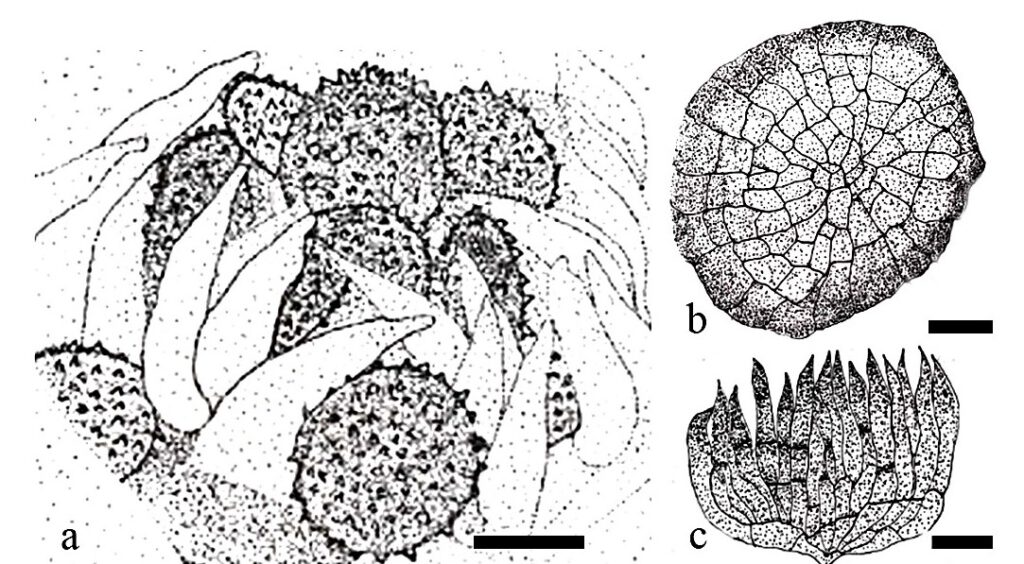Fungalpedia – Note 31 Canasta
Canasta A.A. Carvalho & J.F. Hennen (a synonym of Prospodium)
Citation if using this entry: Fallahi et al. (2023) New genera in 2010-2011. Mycosphere (in prep)
Index Fungorum, Facesoffungi, MycoBank, GenBank, Fig 1.
The asexual genus Canasta with the type species Canasta cruscula was established by Carvalho & Hennen (2010) in Uropyxidaceae, Pucciniales. The genus accommodated three other species, Canasta amphilophii López-Alzate & Salazar-Yepes, Canasta garcesii (F. Kern & Thurst.) A.A. Carvalho & J.F. Hennen, and Canasta oblata A.A. Carvalho & J.F. Hennen, with most causing rust on Bignoniaceae. Canasta is closely related to the genus Prospodium, so that the generic name Canasta was introduced for asexual morphs of species of Prospodium, although the type species Canasta cruscula does not have known sexual morphs. The other three species mentioned in Canasta have sexual morphs that are species of Prospodium. So, based on this evidence, Aime et al. (2018) suggested that Canasta is probably a synonym of Prospodium, and due to its priority, the greater number of species, and widespread use, they recommended the use of Prospodium, and one new combination was introduced; Prospodium crusculum (Basionym: Canasta cruscula) (Aime et al. 2018). Since this is the type species of Canasta, the other species have now become orphaned and should probably be Prospodium species. Canasta cruscula causes rust on the leaves of Distictella elongata. It has uredinia in small dispersed groups on the abaxial side of the leaf. Uredinia are dark cinnamon brown, stipitate, and basket-like. Paraphyses are peripheral, multicellular, incurved, acuminate, and chestnut brown. Urediniospores are ellipsoid to obovoid, cinnamon-colored, with uniform walls, not laminate, echinulate, sometimes smooth in the lower half, with two pores, and equatorial. The name of the genus “Canasta’’ comes from the Latin term “crusculum”, meaning short leg, derived in this context from sorus with a short stalk (Carvalho and Hennen. 2010). No sequence data is available.
Type species: Canasta cruscula A.A. Carvalho & J.F. Hennen (a synonym of Prospodium crusculum)
Fig 1– Canasta cruscula (redrawn from Carvalho and Hennen. 2010). a-c Suprastomatal sori. a Uredinial sori containing the urediniospores and paraphyses. b Bottom view showing the cellular disk-like basis of sori. c Lateral view showing paraphyses and septa of sori. Scale bars: a-c=10 µm.
Other names of the genus: Canasta amphilophii López-Alzate & Salazar-Yepes (should be a synonym of Prospodium amphilophii)
Canasta garcesii (F. Kern & Thurst.) A.A. Carvalho & J.F. Hennen. (should be a synonym of Prospodium garcesii)
Canasta oblata A.A. Carvalho & J.F. Hennen. (should be a synonym of Prospodium oblata)
References
Aime MC, Castlebury LA, Abbasi M, Begerow D, Berndt R, Kirschner R, Marvanová L, Ono Y, Padamsee M, Scholler M, Thines M. 2018- Competing sexual and asexual generic names in Pucciniomycotina and Ustilaginomycotina (Basidiomycota) and recommendations for use. IMA fungus. 9,75-89. https://www.ncbi.nlm.nih.gov/pmc/articles/PMC6048570/
Carvalho AA, Hennen JF. 2010- New species and nomenclature in Prospodium (Uropyxidaceae, Pucciniales) and the new anamorphic genus Canasta in the Neotropics. Mycologia 102, 1096-1113. https://doi.org/10.3852/09-049
Entry by
Maryam Fallahi, Center of Excellence in Fungal Research, Mae Fah Luang University, Chiang Rai 57100, Thailand.
(Edited by Kevin D Hyde)
Published online 23 May 2023
